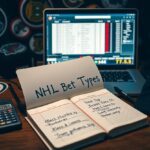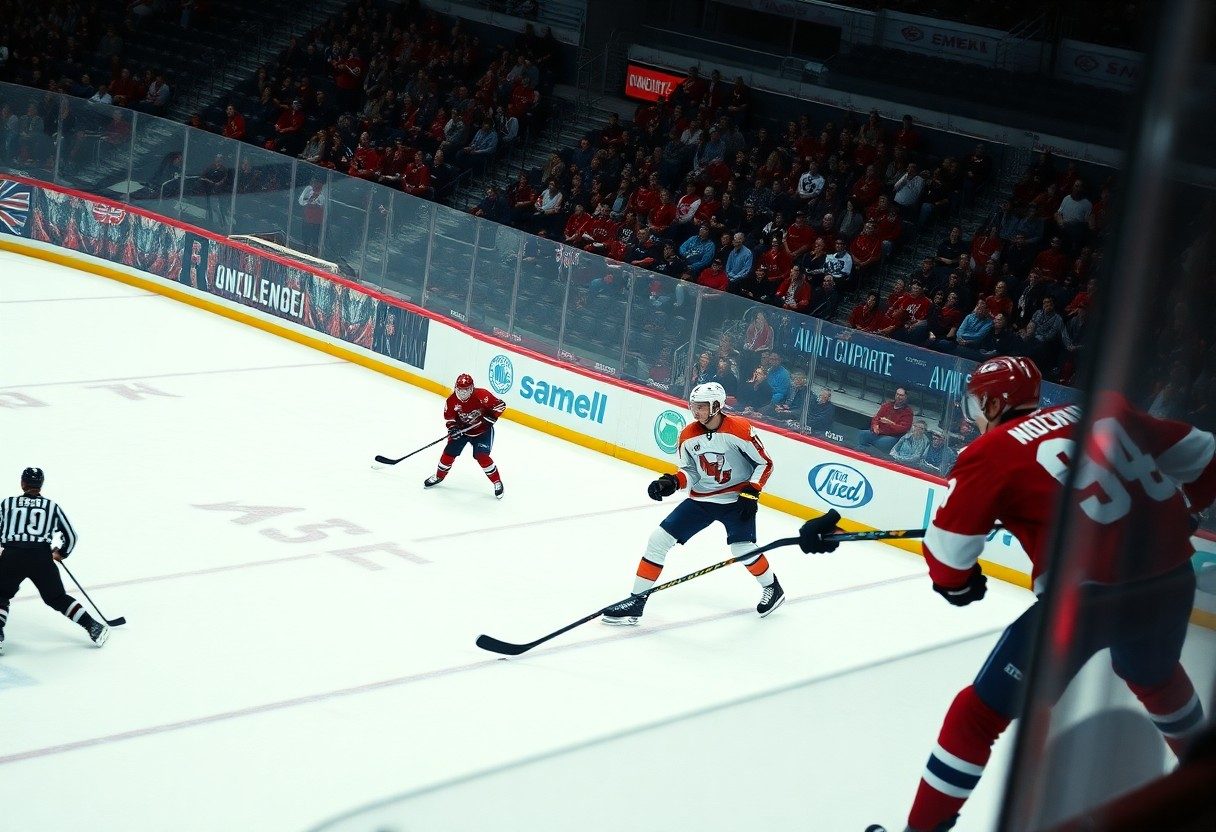Primer on NHL betting reveals necessary information for both novice and seasoned bettors. This comprehensive guide explores various bet types, emphasizing the distinct advantages and potential pitfalls of each. By understanding moneylines, puck lines, and totals, bettors can make informed decisions and enhance their chances of success. Equip yourself with the knowledge to navigate the exciting world of NHL betting effectively.
Understanding Different Types of NHL Bets
In NHL betting, players can choose from various bet types that cater to different strategies and preferences. Key options include:
| Moneyline Bets | Simple wagers on which team will win the game. |
| Puck Line Bets | Wagers that involve a point spread, usually set at 1.5 goals. |
| Total Goals (Over/Under) | Bets on whether the total score will be over or under a set number. |
| Props and Futures | Bets on specific player performances or future outcomes in the season. |
| Parlays | Combining multiple bets into one for higher potential payouts. |
The variety allows bettors to diversify their strategies based on the matchups and conditions.
Moneyline Bets
Moneyline bets are the most straightforward form of wagering in the NHL, where you place a bet on which team will win the game outright. Odds are typically presented with a positive or negative number, indicating the favorite and the underdog. For example, if Team A has odds of -150, you would need to wager $150 to win $100. Conversely, if Team B has +130 odds, a $100 bet would yield a $130 profit if they win. This simplicity attracts many beginners.
Puck Line Bets
Puck line bets introduce a point spread to NHL betting, making games more competitive for wagering purposes. Typically set at 1.5 goals, bettors must predict whether a favored team will win by more than this margin or if the underdog will lose by less than this margin or win outright. This bet type balances the outcome by making the favorite’s win requirement more challenging, often resulting in more favorable odds.
For instance, if Team A is favored by -1.5 goals, they must win by at least two goals for the bet to be successful. Conversely, if Team B is at +1.5 goals, they could either lose by one goal or win outright for the wager to pay off. The puck line is popular among bettors looking for higher payouts compared to straight moneyline bets, especially when there is a clear favorite.
Total Goals (Over/Under)
In Total Goals (Over/Under) betting, you wager on whether the combined score of both teams will be above or below a designated figure set by the bookmakers. For example, if the total is set at 5.5, betting on the over means you expect at least six goals scored, while betting on the under indicates a forecast of five goals or less. This bet type emphasizes offensive and defensive performance trends, making it a favorite for many sports analysts.
This type of bet allows for flexibility, as it can still yield a profit even if your chosen team doesn’t win. Bettors must consider factors such as injuries, recent performance, and individual player stats. This detailed analysis can significantly influence the outcome of total goals, offering opportunities for informed wagering strategies.
Props and Futures
Props and futures bets cover a wide range of outcomes, from specific player achievements (e.g., total goals by a player) to long-term predictions, such as which team will win the Stanley Cup. These bets can offer significant payouts based on unique situations and require a deep understanding of teams and individual player performance.
For instance, betting on a player to score a certain number of goals within a season can be influenced by their previous performance, health status, and team dynamics. Similarly, futures betting can include odds for teams to win conferences or titles long before playoffs. Both prop and futures bets add depth and excitement to NHL betting, allowing for strategic long-term investments based on the bettor’s insights into the game.
Step-by-Step Betting Process
| Step | Description |
| 1. Setting Up Your Betting Account | Choose a reputable sportsbook, complete registration, and verify identity. |
| 2. Research and Analysis | Gather data on teams, players, and historical performance for informed decisions. |
| 3. Placing Your Bet | Select your wager type and amount, then confirm the bet through the platform. |
Setting Up Your Betting Account
Begin by selecting a trusted sportsbook that offers competitive odds and a user-friendly interface. Complete the registration process, providing accurate information. Verification typically involves submitting identification documents to ensure compliance with legal requirements.
Research and Analysis
Effective betting relies on comprehensive research. Analyze team performance, player statistics, injury reports, and match history. Use resources such as advanced analytics and expert opinions to gauge overall trends and insights that can affect the outcome of a game.
Utilize statistical databases, betting odds comparisons, and current news to evaluate key factors like home/away performance and player conditions. Incorporate metrics like Corsi and Fenwick for a deeper understanding of team strengths, helping you make well-informed betting decisions.
Placing Your Bet
After thorough analysis, navigate to your chosen game and select the type of bet you wish to place. Enter your desired wager amount and confirm your selections to finalize the bet. Ensure you’re aware of the odds and potential payouts before completing the process.
Most platforms provide a simple interface for placing bets, outlining potential returns clearly. Pay close attention to the layout of odds to determine risk versus reward effectively, and don’t hesitate to adjust your wager according to the confidence level of your analysis.
Essential Betting Tips
Successful NHL betting hinges on a few key strategies. Focus on the odds provided by various sportsbooks to identify value, and analyze team trends and matchups to enhance your decision-making. Stay updated with line movements which reflect public sentiment and injuries. Always shop around for the best prices on bet types, and consider hedging strategies for more security. Knowing these tips can significantly improve your betting experience.
Bankroll Management
Effective bankroll management is vital for sustainable sports betting. Allocate a specific amount dedicated to betting and avoid exceeding this limit. Utilize a conservative staking plan, betting only a small percentage of your total bankroll on each wager, minimizing exposure to losses. This approach helps in maintaining a long-term betting strategy while still allowing for potential gains.
Timing Your Bets
Strategic timing can greatly influence the outcome of your bets. Placing bets too early might expose you to unwanted line movements, whereas betting too late risks losing value. Analyzing public sentiment ahead of games can yield better odds before heavy betting shifts occur.
Consider betting shortly after line releases for potential advantages or just before the game for last-minute news. For example, if a star player is unexpectedly ruled out, odds may shift dramatically. Timing your bets to capitalize on favorable conditions, such as public overreactions, can maximize your profitability.
Understanding Injuries and Team Dynamics
Injuries and team dynamics are critical factors impacting NHL games. Stay informed about player conditions, as an injury to a key player can drastically alter a team’s performance and betting odds. Strong teams may struggle if their core players are sidelined, while underdogs may gain unexpected strength from returning players.
For instance, analyzing how teams perform with and without certain players can reveal patterns in play and strengthen bet strategies. Additionally, be mindful of how team chemistry is affected by trades or recent acquisitions, as this can shift game outcomes and overall team performance.
Key Factors Influencing Betting Outcomes
Understanding the underlying factors that affect betting outcomes is necessary for making informed decisions. Key influences include team performance metrics, home vs. away games, and historical matchup trends. Evaluating these elements can provide insights into a team’s current form and potential scoring capability. Any bettor who analyzes these criteria effectively will enhance their chances of success.
Team Performance Metrics
Team performance metrics such as goals per game, power play percentage, and penalty kill efficiency are vital for assessing a team’s strengths and weaknesses. Examining these statistics reveals overall consistency and effectiveness, helping bettors predict potential outcomes more accurately.
Home vs. Away Games
The dynamic of home vs. away games significantly influences team performance. Teams often perform better at home due to familiar surroundings and fan support, while away games might introduce challenges such as travel fatigue and unfamiliar rinks. Bettors should investigate how teams historically perform in each setting to make informed decisions.
When analyzing home vs. away games, consider that certain teams, like the Colorado Avalanche, can dominate at home, winning over 70% of their games in recent seasons. In contrast, they might struggle on the road, particularly against competitive teams. Additionally, individual player performances are often impacted by location, as players may feel more pressure during away matches. This insight allows bettors to gauge the likelihood of upsets or dominant performances based on the game location.
Historical Matchup Trends
Exploring historical matchup trends provides context for current performances. Teams facing each other repeatedly develop patterns unique to their encounters, which can greatly influence game outcomes. Analyzing past results helps identify potential advantages or disadvantages based on style of play or matchups.
For example, the rivalry between the Toronto Maple Leafs and the Boston Bruins has produced numerous high-stakes playoff encounters, often characterized by close finishes. Bettors should study these past games, paying attention to key players and tactical changes that have impacted results over time. Recognizing trends, such as one team consistently outperforming another in specific conditions, can refine betting strategies and lead to more informed wagers.
Pros and Cons of Different Bet Types
Pros and Cons of Popular Bet Types
| Bet Type | Pros and Cons |
|---|---|
| Moneyline | Simple to understand; lower risk for favorites. |
| Puck Line | Higher payouts possible; more dynamic betting options. |
| Over/Under | Focuses on scoring; can hedge other bets. |
| Prop Bets | Creative wagering; offers unique betting opportunities. |
| Parlays | Higher potential payouts; combines multiple bets into one. |
Advantages of Moneyline and Puck Line Bets
Moneyline bets are straightforward, appealing to beginners as they require simply selecting the winning team. Puck line bets amplify the excitement by introducing a point spread, which can enhance potential payouts, especially when betting on underdogs. These formats also provide flexibility, allowing bettors to adjust their strategies based on team performance and matchup specifics.
Disadvantages and Risks
Both Moneyline and Puck Line bets come with significant risks that can lead to losses. Moneyline bets favor strong teams, often resulting in lower payouts, while puck line bets necessitate a team to win by a specified margin, increasing the chance of a loss if the game is closely contested.
Moreover, a lack of knowledge about team dynamics or player injuries can negatively impact decisions, leading to misguided confidence. Betting on favorites in Moneyline often entails accepting lower returns, while puck line bets can be misleading if you underestimate the defense or overestimate the offense’s scoring ability. Risk management becomes vital, as overcommitting to one type of bet without considering these factors can adversely affect your bankroll.
Final Thoughts and Best Practices
Effective Bankroll Management
Establishing a solid betting budget is vital; allocate only a small percentage of your bankroll for each wager, ideally between 1-5%. This practice minimizes risk and helps sustain your betting activity over time. For instance, if your bankroll is $1,000, consider a maximum bet of $50. This strategy mitigates potential losses and allows for strategic betting across various markets.
Do Your Research
Statistics and trends can significantly influence your betting decisions. Analyze team performance, player injuries, and head-to-head records before placing bets. For example, a team with a strong home record facing a depleted opponent may present a favorable betting opportunity. Keeping an eye on these details ensures that your bets are based on substance rather than speculation.
Utilize Multiple Sportsbooks
Comparing odds across different sportsbooks can enhance your potential returns. Minor differences in odds can have a substantial impact over the long term. For instance, if one sportsbook lists a team at +150 while another offers +160, the latter can increase your profit margin on successful bets. Always shop around to maximize value.
Final Words
Upon reflecting, understanding the various bet types in NHL betting empowers punters to make informed decisions and enhance their wagering experience. By familiarizing themselves with options such as moneyline, puck line, and totals, bettors can strategically navigate the complexities of the sport. This knowledge not only increases their chances of success but also enriches their appreciation of the game. Armed with this primer, enthusiasts can engage in NHL betting with confidence and a clearer perspective on how to utilize different betting strategies effectively.
FAQ
Q: What are the common types of bets in NHL betting?
A: The most common types of bets include Moneyline bets, Puck Line bets, and Total (Over/Under) bets. Moneyline bets involve picking the winning team. Puck Line bets add a spread of goals that the favored team must win by. Total bets require predicting whether the combined score of both teams will be over or under a specified number.
Q: How does a Moneyline bet work in NHL games?
A: A Moneyline bet is straightforward where you select a team to win the game. The odds reflect the likelihood of each team winning, with favorites typically having a negative value (e.g., -150) and underdogs showing a positive value (e.g., +130). A $100 bet on the favorite at -150 pays $66.67 if they win, while a $100 bet on the underdog at +130 pays $130 if they win.
Q: What is the significance of the Puck Line in NHL betting?
A: The Puck Line is a form of point spread that typically involves a 1.5-goal margin. The favored team must win by at least 2 goals for the bet to be successful. Conversely, the underdog can either win the game outright or lose by 1 goal for the bet to be successful. This betting type adds a strategic element, as it makes games more competitive for wagering purposes.













